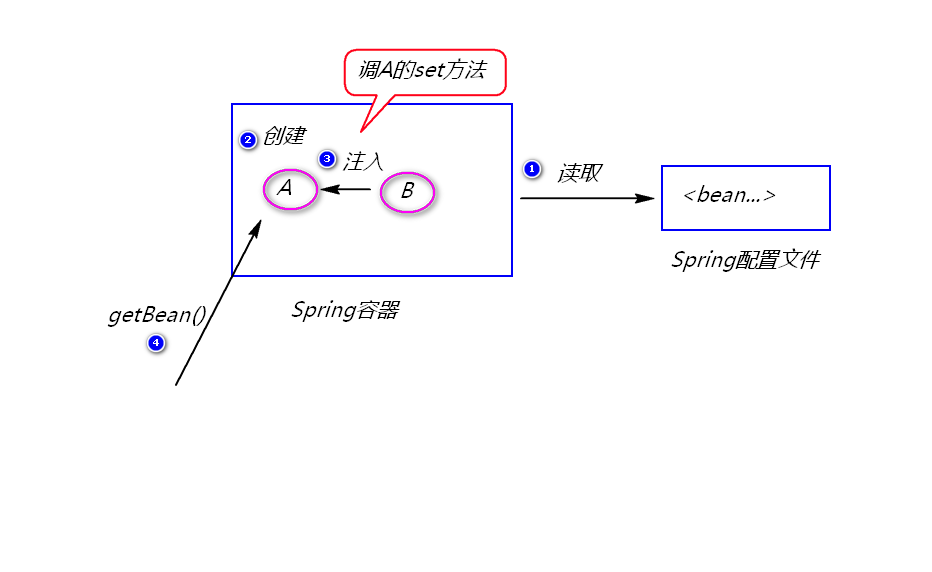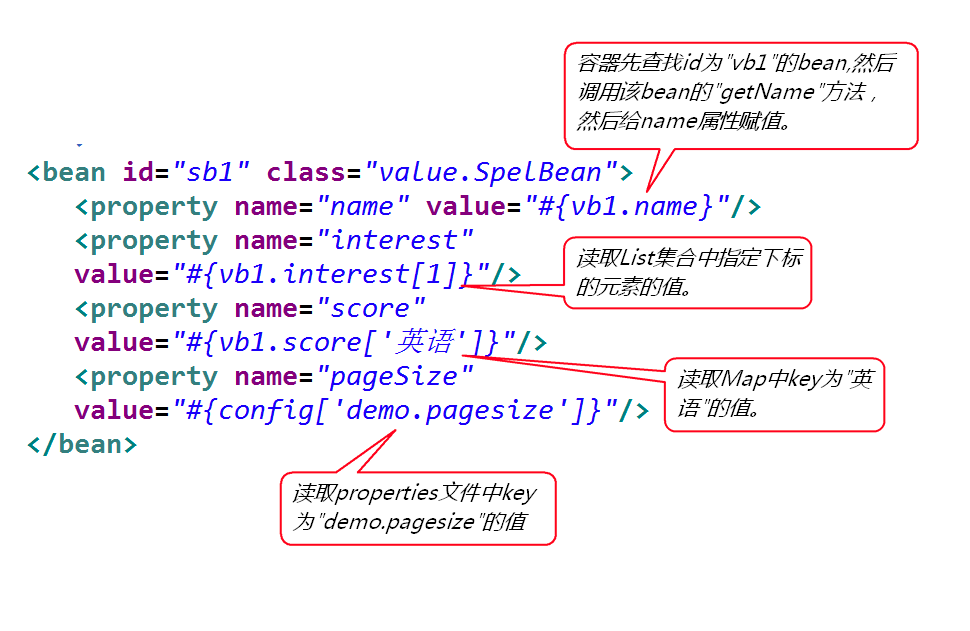(1)什么是IOC(Inversion Of Control 控制反转)?
对象之间的依赖关系应该由容器来建立。
(2)什么是DI(Dependency Injection 依赖注入)?
容器可以通过调用set方法或者构造器来建立对象之间的依赖关系。
注:IOC是目标,DI是手段。
(3)使用set方法来注入
配置set方法注入。property元素的name属性用于指定set方法名(首字母大写,前面添加set),ref属性用于指定被注入的bean的id。
<bean id="a1" class="ioc.A">
<property name="b" ref="b1"/>
</bean>

(4)使用构造器来注入
<bean id="wt1" class="ioc.Waiter"/>
配置构造器注入。constructor-arg的index属性用来指定参数的下标,ref属性用来指定被注入的bean的id。
<bean id="rest1" class="ioc.Restaurant">
<constructor-arg index="0" ref="wt1"/>
</bean>
(5)自动装配
a.自动装配指的是,容器按照某种规则,自动建立对象之间的依赖关系。
即不用明确指定被注入的bean的id,容器底层仍然需要调用set方法或者构造器来完成依赖关系的建立。
b.容器默认情况下,是不会自动装配的。
<bean id="eg1" class="autowire.Enginee"/>
autowire属性用于指定自动装配的方式,有三个值:
byName: 容器以属性名作为bean的id来查找对应的bean,找到之后,调用set方法来完成注入。
注:如果找不到对应的bean,则不注入。
byType:容器以属性类型作为bean的类型来查找对应的bean,找到之后,调用set方法来完成注入。
注:如果找不到对应的bean,则不注入。如果找到多个,则会出错。
constructor:类似byType,只不过调用构造器来完成注入。
<bean id="car" class="autowire.Car" autowire="byType"/>
(6)注入基本类型的值
注入基本类型的值(包括String),使用value属性。
注入基本类型的值(包括String),使用value属性。
<bean id="vb1" class="value.ValueBean"> <property name="name" value="花花"/> <property name="age" value="20"/> </bean>
(7)注入集合类型的值
<bean id="vb1" class="value.ValueBean"> <property name="name" value="花花"/> <property name="age" value="20"/> <property name="interest"> <list> <value>钓鱼</value> <value>做饭</value> <value>看电视</value> <value>看电视</value> </list> </property> <property name="city"> <set> <value>北京</value> <value>洛阳</value> <value>南京</value> </set> </property> <property name="score"> <map> <entry key="english" value="60"/> <entry key="math" value="1"/> </map> </property> <property name="db"> <props> <prop key="username">Tom</prop> <prop key="password">1234</prop> </props> </property> </bean>
(8)引用的方式注入集合类型的值
<util:list id="interestBean"> <value>抽烟</value> <value>喝酒</value> <value>烫头</value> </util:list> <util:set id="cityBean"> <value>长沙</value> <value>岳阳</value> <value>华容</value> </util:set> <util:map id="scoreBean"> <entry key="english" value="90"/> <entry key="math" value="80"/> </util:map> <util:properties id="dbBean"> <prop key="username">Sally</prop> <prop key="password">test</prop> </util:properties> <bean id="vb2" class="value.ValueBean"> <property name="interest" ref="interestBean"/> <property name="city" ref="cityBean"/> <property name="score" ref="scoreBean"/> <property name="db" ref="dbBean"/> </bean>
(9)读取properties文件的内容
读取.properties文件的内容。location属性指定properties文件的位置,容器会读取指定文件的内容,然后将这些内容添加到了Properties对象里面。
<util:properties id="config" location="classpath:config.properties"/>
(10)Spring表达式
